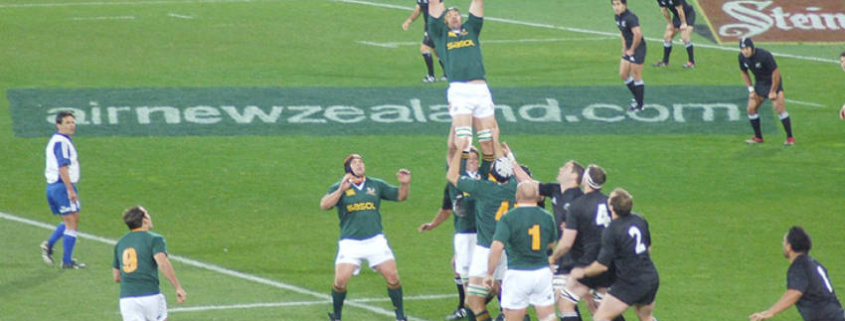Injury to -The Springboks – Rugby Injuries
Mending the Springbok machine
An international rugby player’s body is a finely tuned machine that has taken years to condition. The Rugby World Cup is the greatest challenge any rugby player faces. Running out onto the rugby field under the national flag, voices raised in unision for Nkosi sikelel’ iAfrika, with emotions running high as they wait to face-off against the haka is akin to going into battle.
But every injured player represents a weak link in the chain and it may effect the outcome of the team’s performance and ultimately the score.
Dr Andrew Taylor Still M.D. founder of Osteopathy 1874 said ‘The body is a Unit’, which means one part of the body cannot be separated from another. The “whole” is greater than the sum of its parts, and a disturbance in one part of the body will affect another. So an underlying joint dysfunction in one joint will effect another part of the body, forcing that part to increase its work load and increasing the probability of injury.
For instance: if a rugby player has an under-strength or recovering ankle, it may well place greater demands on the lower leg muscles, knee joint, hip and thigh muscles. This may translate into a reduction in performance – especially towards the latter part of the game.
Naturally, the fittest and most experienced players will be the first choice for selection, but there are limits to the amount of trauma the human body can absorb. Of course, the muscle bulk of rugby players absorbs much of this kinetic energy. Joints are more vulnerable. There will come a point when there is a dip in performance due to the frequency of high-intensity games after a long season or year of play. The dip in preformance will come at the end of the season, but these days there doesn’t seem to be a beginning or an end to the season.
Bodies and trauma memory
Many injuries have long term effects on structure of the body. The scar tissue and muscular contraction that remain long after trauma and injury have resolved themselves can easily upset the mechanical balance of the body. Most of us have experienced the fact that muscles tighten and tense immediately in response to trauma. The area is naturally splinted against movement which may cause further damage.But it’s the after-effect of many injuries that throws out the mechanical balance of the body. For example, an old ankle injury may leave it stiff and off-balance. Such an ankle can cause strain and imbalance higher up in the body which may eventually surface as a knee, hip, lower back, shoulder or neck problem. It may even be responsible for severe headaches. The residue of all trauma, great and small, can influence structural balance and rhythm.
Not always so obvious
Some injuries are so minor, and the initial recovery so quick, that they simply register as a passing ache or pain. This is especially common in the spine. The effects of some jars and shocks may go completely unnoticed, but all eventually exact a penalty on mechanical freedom. Whatever the circumstances the common denominator is the fact that structural trauma disorganises mechanical balance and freedom locally and throughout the body as a whole.
Even though some injuries are unavoidable, the rugby player can help prevent many of them by improving body mobility and function with appropriate exercise conditioning. Every international rugby team has a team devoted to the current performance and injury management of each player.
In addition to injury management, it will be important to ensure that each player is mentally ready for each test match. This will help diminish and extinguish any negative elements there might have been, and remind the Boks that they command great respect from the opposition.
The real glory is being knocked to your knees and then coming back. That’s real glory. – Vince LombardiLooking forward to the future.
Players can also work towards resolving the long term effects of unresolved injuries already sustained by trying a different approach called Osteopathy.
Osteopathy can help you get over most of the above injuries and return to the game quicker. Osteopathy can also help you to reduce the risk of injury in the first place.First and foremost training for the game is vital in the prevention of injuries. Improved technique will help to reduce the possibility of injuries, and increased strength will help as we have more muscle bulk to protect ourselves and our joints. Pre-match stretching and warming up is very important to prevent muscle strains and sprains.
How can a visit to an osteopath reduce the risk of further injury? During a consultation an osteopath will perform a full postural and musculoskeletal assessment to find areas of restriction in muscles, ligaments and joints. Using osteopathic techniques such as massage and manipulation, the health and mobility of these tissues can be improved. Osteopathy can also benefit old injuries by improving the function of damaged tissues.An osteopath will also be able to give specific advice on exercises for rehabilitation of an injured tissue.(Dr Guy Ashburner Osteopath on behalf of the osteopathic profession.)
View a list of common complains that Osteopathy can assist with
Discovery the benefits of Osteopathy
- What is Osteopathy?
- Adult health issues
- Babies and Children
- During and after pregnancy
- Common Complaints
- Testimonials
- Sports Injuries
- Genral Osteopathy FAQs
- The Science & Reasearch



